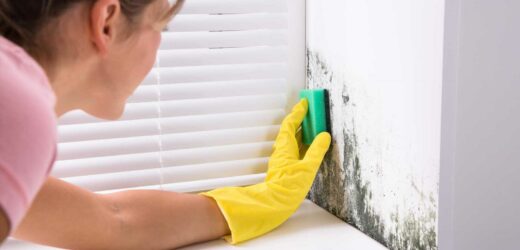IF you discover mould or damp in your home, it’s not just an unsightly pain, it can hit your health and your wealth.
The charity Shelter reckons one in five people across the UK are affected by damp and mould.
“It can hit any homes, from new-builds to listed properties,” says chartered surveyor Simon Wainwright of JPW Real Estate.
“The key is to take action when you see it to stop it spreading and problems becoming costly.”
Mould is a tiny fungus that grows in damp places. Its spores can grow on walls growing fuzzy black, white or green patches.
People living with mould are more likely to suffer from respiratory illnesses, infections, allergies or asthma.
Read more in money
Thousands of households can get up to £128 off their food by filling in a form
Full list of mobile networks that don’t require credit checks
But mould can also damage your home.
Condensation is the main cause of mould in houses across the UK.
It forms in areas with high moisture levels, such as bathrooms and kitchens.
So the key thing to do is try and ensure that you don’t invite mould into your home.
Most read in Money
I spent £665.50 on a burger from food van – getting my cash back is a nightmare
Martin Lewis warns millions of Tesco customers must take urgent action now
I'm a heating expert – the thermostat myth adding £100 to energy bills revealed
Major fashion retailer launches huge closing down sale before stores disappear
Here's Simon's tips on how to avoid it, and ways of tackling it when it appears.
Open windows
“A lot of mould and damp problems are caused by people not ventilating their properties,”says Simon.
“But just by opening windows in your home for say 10 or 15 minutes every morning will help.”
It’s important to get a draught of fresh air through your home to ventilate it properly.
That means opening windows at the front and back of your property. “Think of it as letting the damp out,” he says.
Now is the crucial time to battle mould. “Condensation gets worse in the cold weather,” Simon points out.
That’s because when it comes into contact with a cold window or uninsulated external wall, water droplets form which can lead to mould.
Use a towel
Spotting where water droplets form and dealing with them right away can help avoid mould.
“When you wake up in the morning, you’ll almost always see moisture running down your bedroom windows,” says Simon.
If you mop it up with a towel as soon as you spot it, it will stop it turning into a problem.
“The same is true in bathrooms and kitchens. Have a towel or kitchen roll ready to mop up any damp areas and you’ll be doing a lot to stop mould forming,” he says.
Use pan lids when cooking
Cooking can create a lot of condensation but simply putting a lid on a pot or pan can help.
“Lids help to trap and reduce moisture getting into the air,” says Lee Devlin, managing director at Homecure Plumbers.
He also advises cooks to shut kitchen doors. “That stops condensation spreading to other rooms.”
Another problem is kettles. They produce moisture which has become more noticeable since more people started working from home.
“If you’re constantly making a brew, then you should be thinking about ventilating your kitchen by opening a window,” suggests Simon.
Don’t dry clothes indoors
Many people dry their clothes indoors in the winter months, but that can lead to a perfect breeding ground for mould, warns Lee.
“As the clothes dry the moisture dissipates and, if the home isn’t warm enough or there isn’t enough ventilation, it settles on cold walls and windows,” he says.
If you have to dry clothes indoors because you don’t have a dryer or outside area, ensure they are well-ventilated by opening nearby windows or back doors.
They may take a little longer to dry, but it will be better for your home and your health.
Use a home-made solvent spray
While there are lots of expensive treatments you can buy to treat mould when you find it, make one yourself that is just as effective and will save you money, says Nic Shacklock from
Online-Bedrooms.co.uk.
“Using a homemade solvent spray of white vinegar with water will remove mould on walls,” he says.
Bleach is another easy way to tackle mould.
If the mould is persistent, it could be worth buying a dehumidifier to lower the humidity in the room, he says.
Call in experts
If mould starts to get out of control then you’ll need to identify where the problem is, advises Simon.
“The cause of the mould could be any one of a number of faults, from a leaky roof to problems with showers or washing machines,” he says.
“Get help from an expert to identify the problem and get it sorted,” he says.
Calling in a chartered surveyor may cost around £400 to £600 but could be money well-spent if it helps avoid expensive building work or legal troubles later.
You can find a local surveyor at www.ricsfirms.com
Tenants rights
Landlords have a responsibility to make sure homes are fit for habitation.
If you are living in a rented property, it is the landlord's responsibility to fix a mould problem if it is caused by poor maintenance.
However a tenant must have ventilated a home properly, to avoid facing a possible legal battle with a landlord.
Read More on The Sun
I bought my son his own mini air fryer and I’m obsessed – people say I’m hogging it
Ant McPartlin and ex wife Lisa Armstrong in bitter custody battle over dog
Simon advises tenants to keep evidence of mould by regularly photographing it and keeping copies of any complaints to landlords or building managers.
If you’re unhappy with a landlord’s response you can complain to the Property Ombudsman www.tpos.co.uk/consumers/how-to-make-a-complaint
Source: Read Full Article











